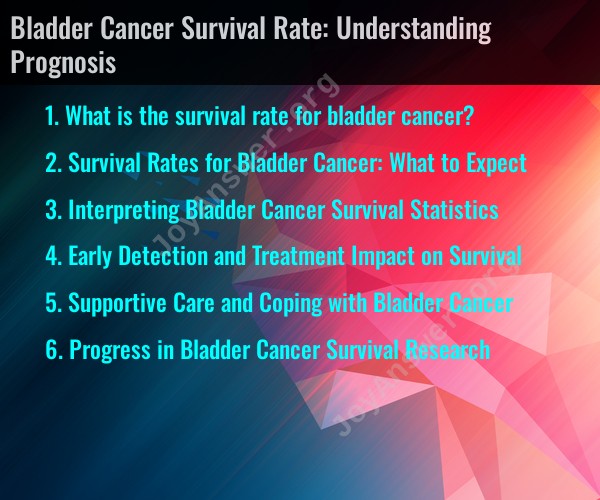What is the survival rate for bladder cancer?
The survival rate for bladder cancer varies depending on several factors, including the stage at which the cancer is diagnosed, the specific type of bladder cancer, the individual's overall health, and the effectiveness of treatment. Survival rates are often reported in terms of the percentage of people who survive a certain number of years after their diagnosis. It's important to note that these rates are general estimates and do not predict the outcome for any specific individual. Here are some general survival rate statistics for bladder cancer:
Five-Year Relative Survival Rate: This statistic represents the percentage of people with bladder cancer who are alive five years after diagnosis, compared to the general population. Keep in mind that these statistics are based on data from previous years and do not reflect the most recent advancements in bladder cancer treatment.
Stage-Based Survival Rates: The stage at which bladder cancer is diagnosed is a significant factor in determining survival rates. In general:
- Early-stage (Stage 0 and Stage I) bladder cancer often has a higher five-year survival rate, with a significant percentage of people achieving long-term survival.
- Invasive or advanced-stage (Stage II, Stage III, and Stage IV) bladder cancer typically has lower survival rates, with more challenging treatment options.
Grade of the Tumor: The grade of the tumor, which reflects how aggressive the cancer cells appear under a microscope, also influences prognosis. High-grade tumors are associated with a higher risk of recurrence and a potentially worse prognosis.
Treatment and Response: The type of treatment and the patient's response to it can significantly affect survival. Advances in cancer treatments, including surgery, chemotherapy, immunotherapy, and radiation therapy, have improved outcomes for many individuals with bladder cancer.
Overall Health: An individual's general health and ability to tolerate treatment play a vital role in survival. People in good health may have a better chance of responding well to treatment.
Age and Gender: Age and gender can influence survival rates. Older adults may have different outcomes compared to younger individuals, and there can be gender-based differences in survival as well.
Recurrent Bladder Cancer: If bladder cancer recurs after initial treatment, the prognosis can be less favorable. The response to subsequent treatments is a critical factor.
It's important to consult with a healthcare provider to discuss your specific diagnosis and prognosis. They can provide you with personalized information based on your unique circumstances. Additionally, ongoing advances in bladder cancer research and treatment continue to improve outcomes and provide hope for individuals diagnosed with this cancer. Early detection and timely, effective treatment can lead to better survival rates.
Survival Rates for Bladder Cancer: What to Expect
The survival rates for bladder cancer vary depending on the stage of the disease at diagnosis. The earlier the cancer is diagnosed and treated, the better the prognosis.
Overall, the 5-year survival rate for bladder cancer is 77%. This means that about 77 out of every 100 people diagnosed with bladder cancer will live for at least 5 years after their diagnosis.
The 5-year survival rates for bladder cancer by stage are as follows:
- Stage 0: 97%
- Stage 1: 71%
- Stage 2: 45%
- Stage 3: 39%
- Stage 4: 7%
Interpreting Bladder Cancer Survival Statistics
It is important to note that bladder cancer survival statistics are estimates. They are based on data from large groups of people who have been diagnosed with bladder cancer. The survival rate for any individual patient will depend on a number of factors, including the stage of the cancer, the patient's overall health, and the type of treatment received.
Early Detection and Treatment Impact on Survival
Early detection and treatment of bladder cancer is essential for improving survival rates. People who are at high risk for bladder cancer, such as smokers and people over the age of 50, should talk to their doctor about screening tests.
If bladder cancer is detected early, it is more likely to be cured. There are a number of treatment options available for bladder cancer, including surgery, radiation therapy, and chemotherapy.
Supportive Care and Coping with Bladder Cancer
Bladder cancer can be a physically and emotionally challenging disease. Supportive care can help patients to cope with the side effects of treatment and improve their quality of life.
Supportive care may include pain management, nutritional counseling, and emotional support. There are also a number of support groups available for bladder cancer patients and their families.
Progress in Bladder Cancer Survival Research
There has been significant progress in bladder cancer survival research in recent years. New treatments have been developed that are more effective and have fewer side effects.
Researchers are also working on new ways to detect bladder cancer early and to prevent it from developing in the first place.
Conclusion
The survival rates for bladder cancer are improving, but there is still more work to be done. Researchers are continuing to develop new and improved treatments for bladder cancer.
If you have been diagnosed with bladder cancer, it is important to talk to your doctor about your treatment options and supportive care needs.




